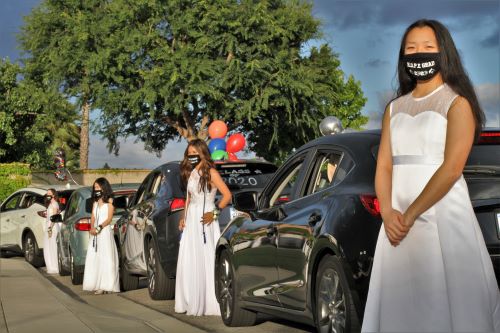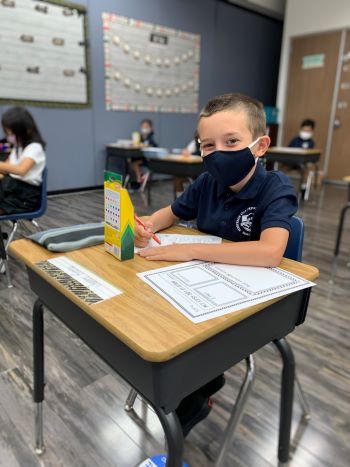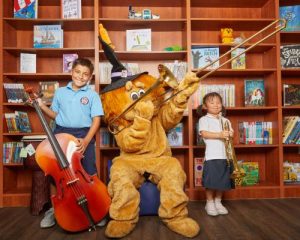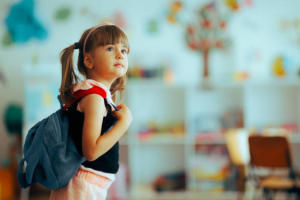The Rise of Alternative Learning
However, not all students returned to school. Some districts brought students back in phases, or chose to bring back elementary school students, but not middle and high school students. And if families were not sending their students back to school, they were seeking out learning alternatives.
Learning pods — aka pandemic pods or micro-schools — was a trend that popped up in Orange County. Parents looked to pods as a way to keep their children from falling behind. The idea was to hold the pods in an outdoor setting with a small group of siblings, friends and/or classmates in a neighborhood and instruction led by a hired teacher or tutor. An informal survey conducted by Forbes found that in August, 33 percent of parents said that their children were in a pod.
Adam Sadri, CEO and academic director at the Irvine-based tutoring facility TutorNerds, said he didn’t notice an increased interest in tutoring services back in March, but it was a different story in the fall. “Parents have been reaching out looking for solutions to help their kids have a successful fall 2020 academic semester,” Sadri told Parenting OC in August. “Parents are also currently interested in implementing small, private, in-person classes and one-on-one, in-person tutoring, in addition to online tutoring.”
Classroom Victories
Despite challenges, Orange County schools have managed to not only adapt but also achieve moments of success.
“While the pandemic is causing frustration, anxiety and disruption to our everyday lives, it is also serving as the basis for lessons on how to handle adversity and manage ourselves in such a way that we don’t allow hardships to tear us down and fracture our communities,” said Mijares.
The Orange County Department of Education distributed nearly 1,800 Internet hotspots to help districts expand their connectivity and supported the mental health needs of students through no-cost training for educators.
“Our department also leads a statewide committee that’s been creating professional development opportunities and resources aligned with California’s Health Education Framework, which helps educators deliver standards-based lessons related to physical, mental, emotional and social health,” said Mijares.
Faculty in both public and private schools reported instances of students taking ownership of their learning. “I am proud of our students’ ability to adapt and their resilience. Not only did we have to transition at the beginning from distance learning to online learning but we had the fires affect our students’ homes directly,” Hanna said, referring to the Silverado Fire that threatened the Portola Parkway area in late October. “They were forced to evacuate and still managed to keep up with their school work. Due to the virus, things are fluid and students have adapted to the various schedule changes we have thrown their way.”
Student progress has proved impressive. “Fairmont students did not experience the ‘COVID slide,’” said Knight Woodley. “Instead, our students actually thrived in spite of the challenges of COVID. Formative testing conducted this fall demonstrated that 88 percent of our students scored in the proficient range from both reading and math. Additionally, 75 percent scored at the high proficiency level in math, and 62 percent did the same for reading.”
Traditionally, eighth-graders at Heritage Oak in Yorba Linda celebrate graduation in white, formal gowns and black tuxedos. When graduation was changed to a drive-through graduation, the graduating class unanimously voted to retain the formal dress tradition and conducted the drive-through graduation in formal attire. “They were able to socially distance around the soccer field, while families remained in cars, and take part in the ceremony,” Cygan said. “They looked fantastic and were very proud of their decision. The excitement and energy generated was greater than a traditional graduation!”
Educators and faculty achieved victories too. “Something I’m personally proud of is that I’ve adapted my classroom to teach both my students at home and online at the same time,” said Hanna. “I’ve also grown a lot as a teacher. As a math teacher I normally have my students do activities in class or on paper. I used technology minimally. Now I am heavily relying on technology and have had to learn how it all works.”
Vaccinations and COVID Tests
“I believe there is light at the end of the tunnel in the form of effective vaccines that, when made available to the general public, will turn the tide against COVID-19,” said Mijares. “In time, our campuses will celebrate the full return of students.”
That time may come sooner than originally anticipated. On Dec. 1, local officials announced that the California Department of Public Health instructed the OC Health Care Agency to prepare to receive 25,350 doses of the Pfizer-manufactured vaccine by Dec. 15. “COVID-19 isn’t over yet,” Orange County Board of Supervisors Chairwoman Michelle Steel said in a statement, “but this first batch of vaccines will help stop the spread of the virus.”
The COVID-19 vaccine is likely to become more readily accessible to the general public in the spring of 2021. The OC Health Care Agency also announced it would be expanding at-home, saliva-based COVID-19 tests to all Orange County residents, regardless of age, income or legal residency status.
According to a press release, the Orange County Board of Supervisors recommended that local health care officials expand the free testing service countywide. The program, which partners with Ambry Genetics, projected that 500,000 at-home test kits would be made available to residents by the end of 2020. Ambry Genetics has the ability to process 4,000 tests each day with a 48-hour turnaround time for notification of results, according to the OC Health Care Agency.
Work in Progress
These steps to mitigate the disease are crucial, but Mijares recognized the academic community will be combating the effects of COVID for some time.
“There is a tremendous amount of work ahead as we continue to customize learning through in-person classes, remote instruction and hybrid models — and as we make plans for what comes next,” Mijares said. “In time, our campuses will celebrate the full return of students. When that happens, it will be critical to assess where each child is at, academically and emotionally, and respond accordingly with trauma-informed care, because we have all experienced trauma in 2020.”
In early December, Southern California officially dipped below the 15 percent capacity mark for available intensive care units. Another regional stay-at-home order, affecting movie theaters, bars, restaurants, amusement parks and other sectors went into effect at 11:59 p.m. on Dec. 6. The new order did not apply to schools that are already open for in-person learning, however. Any campuses that already resumed on-site learning and elementary schools that received waivers to reopen were permitted to stay open.
Schools also had the option to temporarily switch to distance learning and resume in-person instruction at any time, regardless of the county’s tier status, according to recent guidance from the OC Health Care Agency. It’s an option many school districts planned to exercise. Some Orange County school districts did not plan to come back to campus after winter break, but rather participate in distance learning. Brea Olinda Unified School District and Buena Park Elementary planned to return to distance learning until Feb. 1. Santa Ana Unified and Garden Grove Unified School Districts moved to distance learning indefinitely.
Hope for a Brighter Year Ahead
No matter their current learning model, it seems all Orange County schools share the same hope for the 2021/2022 school year: to return to normal.
“I’m hoping that in 2021 we can see [COVID] cases decline and we can return back to school more than just the once a week,” said Hanna.
“I believe that all schools long for the return to a single, on-campus learning environment,” said Cygan. “In speaking with our parents and the students, everyone is very excited and hopeful that major school events and traditions return as quickly and completely as possible.”
Cygan said Heritage Oak staff and families look forward to the return of annual events like the Welcome Back to School Bar-B-Que, the eighth-grade Washington DC trip and the sixth-grade Astro Camp trip. “The traditions are so important in the matriculation from grade to grade. Re-establishing them is a top goal for our entire community,” he said.
Burris said Capistrano Unified is hoping to have a “normal” full-day option for our K-12 students when they open their doors to students on Aug. 17 for the 2021/2022 school year. “Pending health and safety guidelines from the CDPH and OCHCA, of course,” said Burris.
“Our hope for the 2021/22 school year is that we can return to ‘normal,’” said Knight Woodley.
For Fairmont, that would mean that all students are back on campus and without restrictions for things like athletics, fine arts, field trips and pep rallies.
Whatever this new year looks like, Orange County schools will continue to push forward with students’ education as the priority.
“I believe the Orange County Department of Education is well-positioned to support these efforts in concert with our district and community partners,” said Mijares. “After all, today’s students will be the ones to tackle the next generation’s great challenges, and we must maintain a sense of urgency as we do everything in our power to equip them.”
A Typical Day in a COVID World
Capistrano Unified School District offers parents a snapshot of a current typical day for students who partake in on-campus learning. (Hybrid and 100 percent online options are still in place as well.) Though every district and school is different, it’s a helpful outline to set expectations for families in the year ahead.
- “Before Leaving Home: The family takes the temperature of their child and asks if they feel ill. If the child is not feeling well or has a fever of 100.4 degrees or higher, then the child stays home from school. …
- When Arriving at School: Students are wearing their facial coverings as they enter their school campus in an orderly fashion. They enter from multiple entrances to provide appropriate distancing and they go to their assigned spot in their class line which is clearly marked with ‘distancing dots’ on the ground to ensure that students are spaced apart and are facing forward. At some schools they may walk directly to their classroom and then form a line with appropriate spacing outside of the room. …
- During Classroom Instruction: There will be approximately six feet of distancing between the teacher’s desk and teaching space and the students, and students will be seated in rows. Students sit in assigned seats and they are all facing forward to enhance distancing. Approximately 16 students are in the classroom at one time. The teacher strategically spaces students by leaving empty desks between each student. Elementary teachers, special education teachers and related service providers (speech teachers, occupational therapists and adaptive physical education teachers) wear shields so that students can see their facial expressions and watch their instructor’s lips when learning new sounds, language and phonemes. The teachers use a ‘sneeze guard’ plexiglass divider when working with students in small groups or one-on-one for reading assessments. Students have their own Chromebook and their own school supplies to minimize sharing. Except for bathroom breaks and quick outdoor ‘brain breaks,’ students remain in the same classroom and do not travel to other rooms. …
- During Transition to Lunch or Leaving Campus: As students transition to lunch, the custodian arrives and, with the teacher’s assistance, wipes down the common hard surface areas, including door handles, light switches, sink handles, tables and bathroom surfaces (if located in the classroom) with FDA approved sanitizing solutions. Chromebooks, student desks and student chairs are not cleaned because they are assigned only to one student, and the students who will arrive after lunch will use different assigned seating, devices and learning tools. Students wash their hands and eat their lunch in the lunch area with proper distancing, in the classroom, or in another outdoor area. After eating they are able to play outside but they are asked to provide distancing between one another. With distancing, students are able to remove their facial coverings when playing outside.”
By Sarah Mosqueda
(Photos Courtesy of Heritage Oak Private School









Leave a Reply